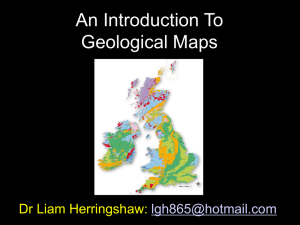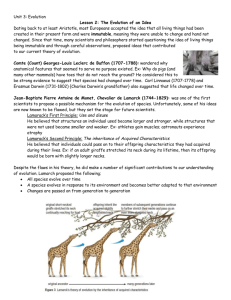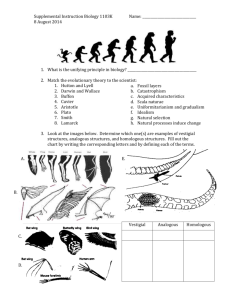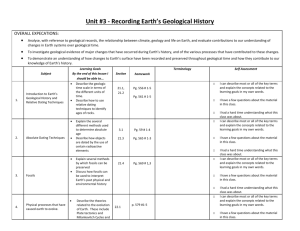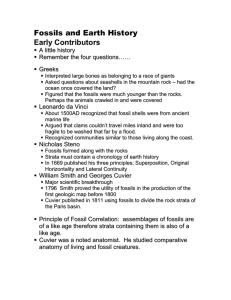Tempo in Geology Catastrophism, Actualism, Uniformitarianism
advertisement
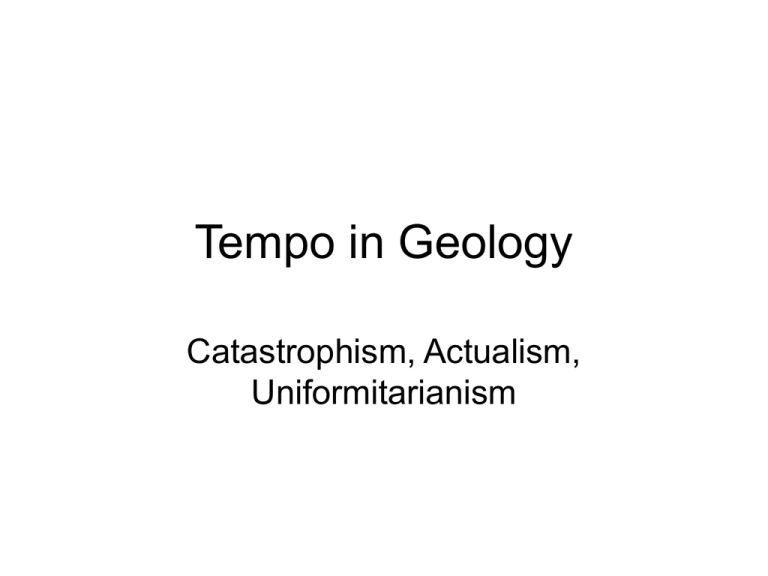
Tempo in Geology Catastrophism, Actualism, Uniformitarianism Dramatis Personae John Playfair • Companion/amanuensis to James Hutton, author of Illustrations of the Huttonian Theory of the Earth (1802). • Argued vigorously for Hutton’s cycles, emphasized the importance of finding granite cross-cutting younger sedimentary formations and volcanic activity that emerges from well below ‘primitive’ formations. • Above all, insists on the vast duration of geological time. Robert Jameson • A Wernerian. • Also a literalist about the biblical chronology (though Werner probably was not). • Founded the Wernerian natural history society in Edinburgh (a split in the Royal Society of Edinburgh). • The Wernerians were focused on the theory; the London society was more ideologically empiricist, wanted to ‘gather facts’ independently of theoretical commitments. (To what extent can this really be done?) Catastrophists and Uniformitarians • Catastrophists explained geological features by appeal to processes that are no longer going on. • They also emphasized the scale, power, speed and violence of these processes • Uniformitarian explanations appealed to processes that continue today, and in the strong form of this position, they also assume that the average rates of these processes have not changed. Some basic distinctions Same basic Laws Same processes Same rates of processes Supernaturalists No No No Catastrophists Yes No No Actualists Yes Yes No Progressivists (a sub-type of the actualists) Yes Yes No (changing steadily— usually decreasing) Uniformitarians Yes Yes Yes Georges Cuvier • A great comparative anatomist– the first to clearly establish the fact of extinction. • The chief proponent of catastrophism. • Not only showed that the continent had been repeatedly flooded by the ocean, but argued also that these floods were ‘convulsive and lethal’. • His argument for this drew on the remains of the last incursion of the sea, in which he included the frozen carcasses of mammoths and wooly rhinos. But (assuming wrongly that these are tropical animals) they could only have been preserved in this way if the freezing temperatures had arrived at the very same time as they were killed. • Further evidence included massive heaps of debris, overturned and faulted strata, and similar dramatic evidence of large-scale geological processes. More of Cuvier’s evidence • The sequence of fossil beds around Paris shows a series of new faunas, each replaced by the next, interrupted by incursions of the sea. • Cuvier concluded that it was these floods that exterminated the previous inhabitants, and that new (related, but different) forms migrated in to replace them. Still More • Foothills of the mountains largely sedimentary rock. • But these are bent/folded/inclined. • These rocks underlie the level strata further from the mountains, so they’re older. • They also contain different fossils, almost all of extinct species. • So their bends etc. are evidence of ancient events that both exterminated these plants and animals, and bent/folded/tilted the strata. • Finally, the highest mountains are more disturbed still, and contain no fossils, indicating a still more violent period during which life was rare if it existed at all. • Finally, large blocks of ‘out of place’ rock (erratics); nothing happening today, Cuvier thought, could have moved these rocks such great distances. Present Processes • Cuvier recognized erosion, landslides, earthquakes and other processes occurring today. • Still, he claimed they just aren’t powerful or significant enough to account for the geological record- especially for the elevation of great mountain ranges. • Cuvier identified the last revolution with Noah’s flood, appealing to other flood stories from other cultures to back up the claim that the oceans and land had changed place (a Hutton-like suggestion) within human history. The age of the earth • Cuvier, like Werner, is vague about time, referring only to ‘thousands of ages’ • Even this was far too much for Jameson, who clung to the Mosaic chronology. • Ironically, today it’s catastrophism that attracts biblical literalists, who appeal to catastrophes (especially the flood) to ‘speed up’ their geology. Charles Lyell • Principles of Geology, Vol. 1 (1830) presented Lyell’s case for uniformitarianism. • Trained as a lawyer, Lyell preferred geology, and was a member of the Geological society before he was called to the bar. • Lyell took on roles in the society, travelled widely with other geologists, did field trips all over Europe and began writing. • On finding that he could actually make a living as a writer, he gave up any notion of working as a lawyer. • Began writing Principles in 1827. Further • Lyell conducted field work in Italy and France, including observations of Etna in Sicily. • In Principles he argued that present processes proceeding at present rates could explain the geological record • The book was controversial and successful, with volumes II and III appearing in 1831 and 1833. He continued to update it, producing 11 editions and part of a 12th. The Theory • Aimed ‘to explain the former changes of the earth’s surface by reference to causes now in operation’. • Granite is an intrusive igneous rock. (Think what this means about the Alps…) • From a uniformitarian point of view, the age of the earth is undeniably immense. • Sources of bias in geology: We don’t see a lot of what’s actually going on! If we were amphibious, we’d do better…cf. also the reversal of things as seen by the ‘sooty sprites’ of the underearth… The importance of time • How fatal every error as to the quantity of time must prove… (p. 141) • The raising of the Andes: Draws on Darwin’s observations of an earthquake in Chile; points out how different things would have to be if we compress the time required to raise them. • The case of Etna & its structure. (p. 143) Etna • Etna rises up through recent Tertiary strata (containing fossils that correspond to living species). • But it is built (as we can see by looking at valleys cut into the mountain) of innumerable separate flows of lava, all comparable in size & form to flows observed historically. • Given the historical rate of such eruptions (even allowing that it might be much higher long ago), we still get an immense time– all of it more recent than these very recent sedimentary strata. Erratics and fossils • Lyell proposed erratics had been carried by icebergs during a time when sea level was much higher and the climate colder. • Fossils of terrestrial animals mixed in with strata formed beneath the sea were formed in river deltas, especially during floods. Objections • Many (and Sedgwick in particular) pointed out that Lyell’s two principles – “No causes whatever have from the earliest time to which we can look back, to the present, ever acted, but those now acting.” – “(T)hey never acted with different degrees of energy from that they now exert.” • seemed unjustified from a theoretical point of view. • How could he rule out different processes, when the laws allow for things that don’t happen today? How could he rule out different rates, when the evidence suggests that the earth is still cooling from an originally molten state? • But the methodological advantages and successful application of these principles were to Lyell’s credit. Sedgwick recants his diluvialism • Our errors were, however, natural, and of the same kind which lead many excellent observers of a former century to refer all the secondary formations of geology to the Noachian deluge. Having been myself a believer, and, to the best of my power, a propagator of what I now regard as a philosophic heresy, and having more than once been quoted for opinions I do not now maintain, I think it right, as one of my last acts before I quit this Chair, thus publicly to read my recantation. We ought, indeed, to have paused before we first adopted the diluvian theory, and referred all our old superficial gravel to the action of the Mosaic flood.... (Sedgwick, 1831, pp. 312-314) Another difficulty for Lyell • As we’ve already seen, the fossils found in Paleozoic, Mesozoic and Cenozoic formations are quite different. • For example, we find no mammals in Paleozoic strata, very few (and odd ones) in Mesozoic, and many & increasingly familiar ones in Cenozoic. • If the world really hasn’t changed how it works in all of geological history, this apparent history of life is awkward to explain. What ‘present causes’ could account for such dramatic changes in living things? Tempos • Tempo giusto: exact/ standard time (no variations, no slowing or speeding up). Thus, Uniformitarian. • Tempo rubato: speeding up or slowing down (at the discretion of the performer). Thus allowing for variation in processes, or at least their rates.
